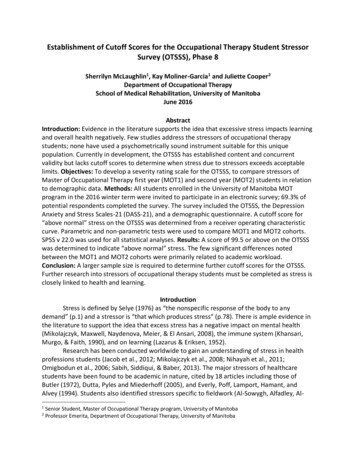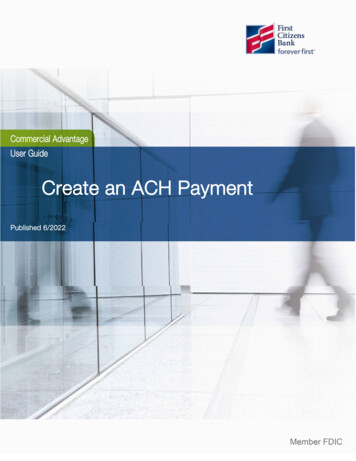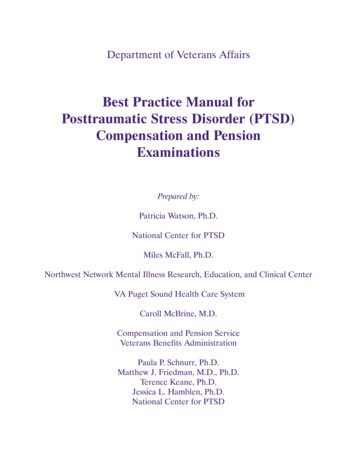
Transcription
Establishment of Cutoff Scores for the Occupational Therapy Student StressorSurvey (OTSSS), Phase 8Sherrilyn McLaughlin1, Kay Moliner-Garcia1 and Juliette Cooper2Department of Occupational TherapySchool of Medical Rehabilitation, University of ManitobaJune 2016AbstractIntroduction: Evidence in the literature supports the idea that excessive stress impacts learningand overall health negatively. Few studies address the stressors of occupational therapystudents; none have used a psychometrically sound instrument suitable for this uniquepopulation. Currently in development, the OTSSS has established content and concurrentvalidity but lacks cutoff scores to determine when stress due to stressors exceeds acceptablelimits. Objectives: To develop a severity rating scale for the OTSSS, to compare stressors ofMaster of Occupational Therapy first year (MOT1) and second year (MOT2) students in relationto demographic data. Methods: All students enrolled in the University of Manitoba MOTprogram in the 2016 winter term were invited to participate in an electronic survey; 69.3% ofpotential respondents completed the survey. The survey included the OTSSS, the DepressionAnxiety and Stress Scales-21 (DASS-21), and a demographic questionnaire. A cutoff score for“above normal” stress on the OTSSS was determined from a receiver operating characteristiccurve. Parametric and non-parametric tests were used to compare MOT1 and MOT2 cohorts.SPSS v 22.0 was used for all statistical analyses. Results: A score of 99.5 or above on the OTSSSwas determined to indicate “above normal” stress. The few significant differences notedbetween the MOT1 and MOT2 cohorts were primarily related to academic workload.Conclusion: A larger sample size is required to determine further cutoff scores for the OTSSS.Further research into stressors of occupational therapy students must be completed as stress isclosely linked to health and learning.IntroductionStress is defined by Selye (1976) as “the nonspecific response of the body to anydemand” (p.1) and a stressor is “that which produces stress” (p.78). There is ample evidence inthe literature to support the idea that excess stress has a negative impact on mental health(Mikolajczyk, Maxwell, Naydenova, Meier, & El Ansari, 2008), the immune system (Khansari,Murgo, & Faith, 1990), and on learning (Lazarus & Eriksen, 1952).Research has been conducted worldwide to gain an understanding of stress in healthprofessions students (Jacob et al., 2012; Mikolajczyk et al., 2008; Nihayah et al., 2011;Omigbodun et al., 2006; Sabih, Siddiqui, & Baber, 2013). The major stressors of healthcarestudents have been found to be academic in nature, cited by 18 articles including those ofButler (1972), Dutta, Pyles and Miederhoff (2005), and Everly, Poff, Lamport, Hamant, andAlvey (1994). Students also identified stressors specific to fieldwork (Al-Sowygh, Alfadley, Al12Senior Student, Master of Occupational Therapy program, University of ManitobaProfessor Emerita, Department of Occupational Therapy, University of Manitoba
Saif, & Al-Wadei, 2013; Peker, Alkurt, Usta, & Turkbay, 2009), relationships (Elani et al., 2014;Pfeifer, Kranz, & Scoggin, 2008); health (Walsh, Feeney, Hussey, & Donnellan, 2010), finances(Marshall, Allison, Nykamp, & Lanke, 2008; Wray & McCall, 2007), and lack of leisure time(Francis & Naftel, 1983; Peker et al., 2009).A wide variety of instruments has been used to quantify stressors in students. Mosthave been designed by the authors themselves for the purpose of their study (Mason, 2006;Nihayah et al., 2010; Omingbodun et al., 2006; Pfeifer et al., 2008); reports on these studieslack information about validity. Other studies of student stress (Jacob et al., 2012; Jacob,Itzchak, & Raz, 2013; Tucker, Jones, Mandy, & Gupta, 2006; Walsh et al., 2010) have usedgeneric questionnaires such as the Undergraduate Sources of Stress Questionnaire (USOS) toidentify stressors in healthcare students. Garbee’s Dental Environment Stress (DES)questionnaire (1981) has been used in several studies of stressors of dental students (AlSowygh et al., 2013; Elani et al., 2014; Peker et al., 2009) and has also been modified byresearchers seeking to identify stressors in occupational therapy students (Everly et al., 1994)and physiotherapy students (Francis & Naftel, 1983).Much of the existing research has focused on identifying stressors in healthcarestudents, who are exposed to high levels of stress during their programs of study. In particular,much attention has been paid to stressors of dentistry students, medical students, andphysiotherapy students. Research on stressors of other health professions provides insight intosome of the stressors of healthcare students in general. However, due to the nature of thediffering programs of study, occupational therapy students may experience stressors uniquefrom those of students from other healthcare disciplines. Few studies address the stressors ofoccupational therapy students, and none have been found that have used a reliable and validinstrument suitable for this unique population. Therefore, there is a need to develop aninstrument that quantifies the severity of stress related to stressors of occupational therapystudents. To that end, a series of projects has been carried out to develop and validate such aninstrument. The Occupational Therapy Student Stressor Survey (OTSSS) was created; contentvalidity was established through iterative consultation with occupational therapy students andprincipal component analysis. Concurrent validity was determined by comparing results of theOTSSS to the Medical School Learning Environment Survey-Revised, the DASS21, and the K-10instruments. While the OTSSS has been shown to be valid, the relationship of the scores tolevels of stress remains to be determined.ObjectivesThe primary objective of this study was to develop a severity rating scale for theOccupational Therapy Student Stressor Survey (OTSSS) (Appendix C) to quantify the stress levelsof occupational therapy students. The research hypothesis is that the total OTSSS scorescorrelate positively with the DASS21 Stress subscale; therefore, cutoff points for “abovenormal” stress can be determined. A secondary objective of the study was to compare scores ofMOT1 and MOT2 student stressors in relation to demographic data obtained from a shortdemographic questionnaire (Appendix C). The research hypothesis is that there is a differencein OTSSS total score and subscores between MOT1 and MOT2.DesignThis study used a quantitative cross-sectional survey design.2
MethodsParticipantsAll students enrolled in the 2016 winter term of the Master of Occupational Therapy(MOT) program at the University of Manitoba (U of M) were invited to participate in the study.Of the 101 eligible students, 50 were MOT 1 and 51 were MOT 2.RecruitmentA modified Dillman’s technique (2000) was used to recruit participants. An e-mail letterof invitation was distributed to the class e-mail lists and a Facebook message was posted to theSMR-MOT Facebook group page. Potential participants received two reminder e-mails andFacebook posts in addition to the initial invitations. Recruitment posters were also displayedthroughout the College of Rehabilitation Sciences building. All recruitment materials includedthe name of the study, the names of the investigators, general information about the studytopic, inclusion criteria, timeline of the study, participation incentives, contact information ofthe principal investigator, and a link to the online survey.Participants were provided with an incentive to complete the survey – eligibility to entera draw for two Starbucks gift cards valued at 15 each, one for each class (MOT1 and MOT2).The co-investigators were not eligible to enter the draw.InstrumentThe instrument used in this study has three sections: the OTSSS, the DASS-21, and ademographic questionnaire.Occupational Therapy Student Stressor Survey. The OTSSS is designed to quantify thestressors of occupational therapy students. It is a 45-item questionnaire initially derived fromthe DES questionnaire; it asks respondents to rate stressors on a 4-point Likert scale (Lam &Salins, 2011). Items were modified over several years based on stressors identified byoccupational therapy students at the U of M (Antoniak & Creighton, 2009; Bazin & Vermeylen,2010; Bubnowicz & Manness, 2012). Content validity and concurrent validity have beenestablished and the instrument has been piloted with first and second year MOT students(Carey & Chen, 2015).Depression, Anxiety, and Stress Scale-21. The DASS-21 was used to collect data ondepression, anxiety, and stress levels of participants. The questionnaire contains three, 7-itemsubscales for each of depression, anxiety, and stress that are rated on a 4-point Likert scale.Psychometric properties of the DASS-21 have been published. A study by Henry and Crawford(2005) reported the internal consistency reliability of the DASS-21 as α .93, as well as thereliability of the individual subscales of depression (α .88), anxiety (α .82), and stress (α .90).Concurrent validity has been established with the Rosenberg Self-Esteem Scale (α .91) and theSF-8 Health Survey, two well-established measures of physical and mental well-being withsound psychometric properties. Convergent validity has been established for all DASS-21subscales with the Mental Component Summary score and divergent validity with the PhysicalComponent Summary score from the SF-8 Health Survey (Sinclair et al., 2012).Demographics. The demographics section of the questionnaire consists of 23 itemsintended to gather general information such as age, gender, education, employment status,relationship status, and financial concerns. The survey includes single-response multiple-choiceand text response boxes to accommodate a multitude of possible responses. The items3
included in this section of the instrument were selected based on a review of the literature.ProceduresThis study was reviewed and approved by the University of Manitoba Health ResearchEthics Board.Data collection. An electronic link to the survey was emailed to all potentialparticipants. The survey was mounted on Fluid Surveys, a web-based application, and wasavailable for access for a two-week period.Data management.Data survey. The electronic files with the survey data were downloaded from FluidSurveys in both Excel and SPSS (v22.0) formats and stored as password-protected files in aDropbox folder with access limited to the investigators.Incentive survey. The electronic file with the personal information for incentives wasdownloaded from the Fluid Surveys website and stored as a password-protected Excel file in aDropbox folder with access limited to the support personnel who distributed the incentivesafter the survey had been closed.Data analysis. Inferential data analyses were carried out with SPSS version 22.0.Significance was set at p 0.05. A cut-off value for severity of stress on the OTSSS wasestablished by comparing participants’ OTSSS total scores and sub scores to their Depression,Anxiety and Stress Scale-21 (DASS-21) total scores and Stress sub scores, as the DASS-21 has anexisting severity rating scale. To determine a cutoff score for the OTSSS, a receiver operatingcharacteristic (ROC) curve was generated; input data was scores from the OTSSS anddichotomous data from the stress subscale of the DASS with 0 as Normal (DASS-S score of 0-14)and 1 as Above Normal (DASS-S score of 14). Levene’s test was used to determine equality ofvariances in the OTSSS and DASS data. Comparison of MOT1 and MOT2 OTSSS data was donewith t-tests for independent samples while the Mann-Whitney test was used for the DASS data.Spearman’s rho test was used to determine correlation coefficients between the subscores ofthe OTSSS and those of the DASS.ResultsA total of 101 MOT students were invited to participate in the survey; 50 were MOT1and 51 were MOT2. The total response rate was 69.3% (n 70). Of all participants, 40% wereMOT1, 58.6% were MOT2, and 1.4% did not disclose their year of study. Fifty six percent ofeligible MOT1 students participated in the survey (n 28), while 82% of eligible MOT2 studentsparticipated (n 41).Objective 1: Development of Severity Cutoff Scores for the OTSSSTests for normal distribution. The Shapiro-Wilk Test of Normality was used todetermine whether the participants’ OTSSS and DASS21-Stress scores were normallydistributed (Appendix A). Participants’ OTSSS scores followed a normal distribution (p .019),while their DASS-21 Stress sub scores did not. Because only one of the two instruments wasnormally distributed, a Spearman’s rho was used to test for correlation between the twoinstruments.OTSSS-DASS stress subscale correlations. The Total OTSSS scores were found tocorrelate positively with the DASS21 Stress sub scores (r .499, p .000; Appendix A).Furthermore, the academic workload (r .529; p .000), fieldwork (r .253; p .036),4
relationships (r .488; p .000), and health (r .363; p .002) sub scales also correlatedsignificantly with the DASS21 stress sub scale.Receiver operating characteristic (ROC) curve. The cutoff value for “normal” stress on theOTSSS was established using an ROC curve for scores on the DASS21-Stress sub scale. The cutoffvalue indicating a higher than “normal” level of stress is an OTSSS total score above 99.5. Figure1 shows the ROC curve that was used to determine the cutoff point that best balances theinstrument’s specificity and sensitivity. At an OTSSS total score of 99.5, the test has a sensitivityvalue of .778 and a 1-specificity value of .381.Figure 1. ROC curve to determine cutoff score for “normal” level of stress on the OTSSS.Objective 2: Comparison Between MOT1 and MOT2OTSSS Responses. The OTSSS items that were rated most stressful for the entire cohortare presented in Table 1. The total (%) column represents the proportion of participants whorated these items as either “moderately stressful” or “very stressful”. Three of the top fivehighest ranked stressors were academic in nature (“exams, assignments, and grades”, 86%;“volume of course work”, 81%; and “long study hours”, 80%), while one was related tofieldwork education (“being a competent OT after grad”, 86%), and the other related to health(“high expectations for self”, 80%).5
VeryOTSSSModerately Stressful TotalOTSSS ItemSubscale Stressful (%)(%)(%)27. Exams, assignments, and gradesAcademic49378613. Being a competent OT after gradFieldwork30568637. Volume of course workAcademic40418111. High expectations for selfHealth3446804. Long study hoursAcademic433780Table 1. OTSSS Stressors most frequently rated as “moderately stressful” or “very stressful” byparticipants.Few statistically significant differences were found when comparing mean itemresponses on the OTSSS between MOT1 and MOT2 cohorts (Table 2). The MOT1 cohortperceived the following items as significantly more stressful than the MOT2 cohort: “knowledgeexpected from me because of my pre-requisite courses” (p .002), “unclear instructions onassignments” (p .046), “varying styles of instruction and teaching” (p .029), and “difficultyapplying knowledge in a practice setting” (p .004).ItemAcademic Workload1. Knowledge expected from me because of my prerequisite courses6. Unclear instructions on assignments34. Varying styles of instruction and teachingFieldwork19. Difficulty applying knowledge in a practice .462.711.95.400.513.046.0292.612.05.558.004Table 2. OTSSS items with significant differences between MOT1 and MOT2 cohorts.Demographic data. One objective of this study was to examine the relationshipbetween demographic data and participant OTSSS responses using a Spearman’s rhocorrelation coefficient. It was predicted that certain demographic variables would correlatewith specific items on the OTSSS. For example, a positive correlation was predicted betweenfinancial demographic questions such as employment status and level of debt to financial andacademic stressors obtained from the OTSSS. However, no significant correlations were foundfor the demographic-OTSSS variables that were analyzed (Table 3).6
Demographic Variable3. AgeOTSSS Item38. Need to be a lifelong learner inconstantly changing environment15. Employment Status5. Lack of sleep23. Lack of free time44. Number of hours spent in class10. Relocated for OT program30. Financial debtTable 3. Correlation of Demographic Variables and OTSSS Items.rs-.026p-value .05.081-.013.073-.054 .05 .05 .05 .05DiscussionObjective 1: Development of Cutoff Scores for the OTSSSOTSSS-DASS21 stress sub scale correlations. Confirming the initial hypothesis, the totalOTSSS scores and academic, relationships, and health sub scales were found to correlatepositively with the DASS21 Stress sub scale. As the DASS21 is an instrument with cutoff scoresthat has been shown to have excellent psychometric properties (Henry & Crawford, 2005;Sinclair et al., 2012), it was possible to determine a cutoff point for the OTSSS using a ROC curvefor scores on the DASS21-Stress sub scale. The positive correlation between the scores of thetwo instruments indicates that as student occupational therapists report higher severity ofstressors on the OTSSS, they are more likely to exhibit symptoms of stress such as irritability,difficulty relaxing, and tension (Henry & Crawford, 2005).ROC curve. As determined from the ROC curve, an OTSSS total score of 99.5 or abovewas found to indicate “above normal” stress, while a score of less than 99.5 indicates “normalstress”. The area under the curve (AUC) chosen for the cutoff point was .778, meaning that theOTSSS can be used to accurately detect “above normal” stress 77.8% of the time. Although acutoff point was found, these results are not ideal as the optimal value for the AUC thatrepresents a perfect test is 1.00 (Portney & Watkins, 2009). A value of .778 means that there issome risk of false positives; in other words, it is possible to falsely identify a participant ashaving “above normal” stress when in reality the individual falls within the “normal” range forlevel of stress. A higher AUC is required to develop further cutoff scores for the OTSSS, whichmay be achieved with a larger sample size. Ideally, graded cutoff points similar to those of theDASS21 (Lovibond & Lovibond, 1995) will eventually be established for the OTSSS.Objective 2: Comparison Between MOT1 and MOT2OTSSS responses – MOT1 and MOT2 combined. The findings of this study areconsistent with previous studies that reported academic stressors as the most significantstressors among healthcare students (Butler, 1972; Dutta et al., 2005; Everly et al., 1994).“Exams, assignments and grades” (86%), “volume of course work” (81%), and “long hours ofstudy” (80%) were most frequently rated as “moderately stressful” or “very stressful” byparticipants. These results reflect the high academic demands of the condensed graduate twoyear U of M MOT program.Similar to other studies that reported fieldwork or clinical placement as a stressfulexperience among health professions students (Al-Sowygh et al., 2013; Peker et al., 2009),“being a competent OT after grad” was rated as “moderately stressful” or “very stressful” by86% of participants. It is possible that “being a competent OT after graduation” was rated as a7
high fieldwork stressor because of the wide variety of occupational therapy roles to which theMOT students are exposed on their fieldwork placements, which can potentially beoverwhelming. Additionally, the U of M MOT program exposes students to four fieldworkplacements interspersed between academic blocks, meaning that they become aware of whatit is expected from them in practice before they have completed the academic portion of theprogram. Although this curriculum structure likely has long-term benefits as it teaches studentsto be self-directed learners throughout their careers, it can be difficult for students to adjust toinitially.Consistent with the literature, health was not found to be a major stressor overall.However, one health item on the OTSSS (“high expectations for self”) was rated among the topfive stressors for participants. One possible interpretation for this finding is that highexpectations for self could be correlated with academic achievement in university. Being acompetitive-entry graduate program, the MOT program likely attracts high-achieving studentswho hold high expectations for themselves. This OTSSS item contrasts with the majority ofprevious studies that did not find health to be a major stressor for students. An exception is astudy by Walsh et al. (2010) that found overall health concerns and mood to be highly ratedstressors for physiotherapy students.OTSSS responses – MOT1-MOT2 comparison. Interestingly, only four statisticallysignificant differences were found between the two cohorts, with three pertaining to academicworkload and one to fieldwork. It is not unexpected that the majority of statistically significantdifferences were related to academic stressors as the content, focus, and demands of thecurriculum are quite different between years one and two of the program.Participants from the MOT1 cohort were more stressed than participants from MOT2about the knowledge expected from them because of the prerequisite courses completed.These findings may reflect that MOT1 students are still adapting to a graduate style of learningas they are newer to the program than MOT2s. Graduate programs are highly specialized, skillsbased, and require students to apply previous knowledge to succeed in the fast pacedcurriculum. Students that are new to graduate-style learning likely come from undergraduateprograms that are less specialized. Another explanation is that the U of M MOT programaccepts students from a variety of undergraduate programs; therefore, students have a widerange of academic backgrounds. Consequently, some students might feel they lack knowledgein an area when comparing themselves to others in their cohort who completed anundergraduate program that is more related to a health discipline. For example, MOT studentswith a background in kinesiology might feel better prepared for anatomy-related courses thanMOT students with an undergraduate psychology background, yet feel as though theirundergraduate education did not prepare them for the mental health components of the MOTcurriculum.The significant differences between the MOT1 and the MOT2 cohorts on the OTSSS item“varying styles of instruction and teaching” may also be explained by the transition periodundergone by first year students who are still adapting to the graduate style of education. Tosucceed in the U of M MOT program students are required to work closely with instructors,often in a small group setting, which differs greatly from large classroom instruction typical ofmost undergraduate programs. Additionally, multi-step comprehensive assignments are a bigcomponent of the U of M MOT program and require self-directed learning skills that are seldom8
taught in undergraduate studies. Hence, it is not surprising that MOT1 students perceive“unclear instructions on assignments” as more stressful than MOT2 students who have mostlikely developed the skills needed to master these tasks.Furthermore, the MOT1 participants reported more stress related to the OTSSSfieldwork item “difficulty applying knowledge in a practice setting”. This result might reflect theMOT1’s limited exposure to fieldwork placements at the time the survey was launched. BothMOT1 and MOT2 completed the survey during their second term, at which point MOT1 hadonly completed one four-week placement while MOT2 had completed three placementstotaling twenty weeks of fieldwork. Consequently, the MOT2’s exposure to three differentpractice settings might contribute to a greater level of confidence when applying knowledge ina practice setting.Demographic data. In contrast to the preliminary hypothesis, the analyzed demographicvariables did not correlate significantly with specific items on the OTSSS. The lack of correlationbetween the demographic variable “age” and the OTSSS item “need to be a lifelong learner inconstantly changing environment” may suggest that the U of M MOT program attracts flexibleand highly motivated students who are lifelong learners at every life stage.Surprisingly, the demographic variable “employment status” did not correlate with anyof the following OTSSS items: “lack of sleep, “lack of free time”, and “number of hours spent inclass”. Several inferences can be made from these findings. The U of M MOT program is highlydemanding and poses great academic expectations for all students despite their employmentstatus. Although students who hold jobs may experience additional challenges of some formdue to their responsibilities outside of the program, all students in the MOT program may findlack of sleep, lack of free time, and number of hours spent in class equally stressful.Having to relocate to attend the MOT program did not correlate with the OTSSS item“financial debt”. Again, this finding did not support the hypothesis that these two items wouldbe positively correlated, as it can be assumed that cost associated with relocation is a majorcontributing factor to student debt. However, based on the results, this did not appear true forthe U of M MOT cohort. Sixty-seven point five percent of respondents indicated that theyreceived support from parents or family members, while 15.6% received financial help from aspouse or partner. Hence, receiving financial support from an external source may be amitigating factor for financial debt.LimitationsAn uneven proportion of respondents from MOT1 (n 28) and MOT2 (n 41) may havecontributed to the low number of statistically significant differences between the two cohortsas it is difficult to draw conclusions when sample sizes are so different. It is difficult to interpretwhy fewer MOT1 students participated in the survey. The nature of a cross-sectional surveydesign may have been one factor as the MOT1s were in the midst of a busy semester while theMOT2s were in the second week of their semester. Alternatively, there may have been aresponse bias as the MOT2s knew the co-investigators well and therefore were more willing toparticipate in their survey.A second limitation was the small sample size overall, which limited the ability to derivea severity rating scale for the OTSSS. Although a cutoff value for “normal” stress on the OTSSSwas found, a larger sample size is required to generate further cutoff values for this instrument.A third limitation of the study is that it involved participants from only one university;9
therefore, caution must be taken when generalizing these results to other occupational therapyprograms as their curricula may differ from that of the MOT program at the U of M.RecommendationsThe limited sample size may have contributed to non-significant correlations betweenthe OTSSS and demographic items and restricted the number of cutoff scores that could bederived from the OTSSS. It is recommended that this study design be repeated with a largersample size to develop further severity cutoff scores for the OTSSS. To achieve this, the studydesign should be repeated in the 2016-2017 year and the data be combined with that of thecurrent year.This study has additional implications that may inform additions or changes to the U ofM MOT curriculum as data were collected regarding the most significant stressors for students.As academic stressors such as “exams, assignments, and grades” were rated most stressful, itmay be beneficial to future students’ health to make adjustments or modifications to thecurriculum based on items that were rated as being most stressful. Repetition of the studydesign with a larger sample size would increase the strength of these findings.ConclusionOverall, this study has contributed to current understanding of the experience of stressin occupational therapy students. Further research into stressors of occupational therapystudents should be completed as stress is closely linked to health and learning. This studyrepresents a preliminary effort to create a severity rating scale for the OTSSS; a larger samplesize will be required to determine further cutoff scores for the OTSSS and to increase thestrength of the current findings on stressors of occupational therapy students.10
ReferencesAl-Sowygh, Z.H., Alfadley, A.A., Al-Saif, M.I., & Al-Wadei, S.H. (2013). Perceived causes of stressamong Saudi dental students. King Saud University Journal of Dental Sciences,4(1), 7-15.doi:10.1016/j.ksujds.2012.11.002Antoniak, G. & Creighton, N. (2009). The development of content validity in an instrument tomeasure stress in master of occupational therapy students. Unpublished IndependentStudy paper. University of Manitoba, Winnipeg MB.Bazin, K. & Vermeylen, A. (2010). Establishing content validity of a stressor survey for masterlevel occupational therapy students. Unpublished Independent Study paper. University ofManitoba, Winnipeg MB.Bubnowicz, N. & S. Manness (2012). Development of content validity in an instrument tomeasure stress in Master of Occupational Therapy Students. Unpublished IndependentStudy paper. University of Manitoba, Winnipeg MB.Butler, H.F. (1972). Student role stress. The American Journal of Occupational Therapy, 26(8),399-405.Carey, B. & Chen, N. (2015). Perceived stressors of occupational therapy students. UnpublishedIndependent Study Paper. University of Manitoba, Winnipeg MB.Dillman, D. M. (2000). Mail and Internet Surveys: The Tailored Design Method (2nd ed.).United States of America: John Wiley & Sons, Inc.Dutta, A.P., Pyles, M.A. & Miederhoff, P.A. (2005). Stress in health professions students: Mythor reality? A review of the existent literature. Journal of National Black Nurses Association,16(1), 63-68.Elani, H.W
All students enrolled in the 2016 winter term of the Master of Occupational Therapy (MOT) program at the University of Manitoba (U of M) were invited to participate in the study. Of the 101 eligible students, 50 were MOT 1 and 51 were MOT 2. Recruitment A modified Dillman's technique (2000) was used to recruit participants. An e-mail letter











